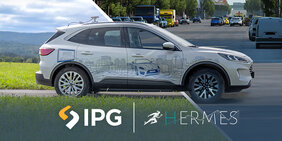The development of automated driving functions is reaching new frontiers – especially when it comes to understanding how people experience these technologies and if they trust them. In complex traffic scenarios, changing ambient conditions, or country-specific contexts, purely technical validation criteria are often no longer sufficient. New methods are needed that specifically consider the users’ subjective sense of safety, comfort, and acceptance.
This was the starting point for the research project HERMES. In collaboration with the Institute for Driver Assistance and Connected Mobility at Kempten University of Applied Sciences, IPG Automotive and other project partners worked on human-centered methods for realistic simulation, evaluation, and optimization of automated driving functions. The goal was to gain insight into how different driving scenarios, especially with mixed traffic, affect human perception of safety, comfort, and acceptance.
Virtual testing with real impact
The project focused on analyzing the interactions between test participants and the automated vehicle across various development stages. Advanced simulation methods were applied to represent, test, and continuously improve real components within virtual environments. IPG Automotive’s simulation solutions enabled two key application scenarios: driver-in-the-loop and vehicle-in-the-loop.
In the driver-in-the-loop approach, driving simulation was combined with test participants for a detailed examination of human-vehicle interaction under realistic conditions. For this purpose, IPG Automotive’s simulation platform CarMaker was seamlessly integrated into the driving simulator at Kempten University. This allowed for the realistic representation of complex scenarios from highly detailed real-world measurements as well as from the Euro NCAP 2026 package, including numerous safety-relevant variations. Combined with eye-tracking methods, participant behavior was analyzed in depth which provided valuable insights into subjective safety perception, comfort, acceptance, and situational driving behavior in interaction with automated driving functions.
Additionally, the application of vehicle-in-the-loop (VIL) in a real test vehicle was a key aspect. Here, virtual objects from CarMaker were superimposed onto the vehicle’s real camera feed. The test vehicle recognized these elements and responded autonomously by braking automatically for instance. This approach enabled controlled testing of both vehicle behavior and interaction with real hardware. Even complex maneuvers and swarm scenarios involving multiple vehicles were safely simulated and tested.
Conclusion
HERMES demonstrated how to evaluate automated driving in a realistic and user-centered way. With its simulation platform CarMaker, IPG Automotive contributed essential technologies for analyzing safety, comfort, as well as acceptance, both virtually and in real vehicles. IPG Automotive thus played a key role in the practical development of trustworthy automated driving functions.
